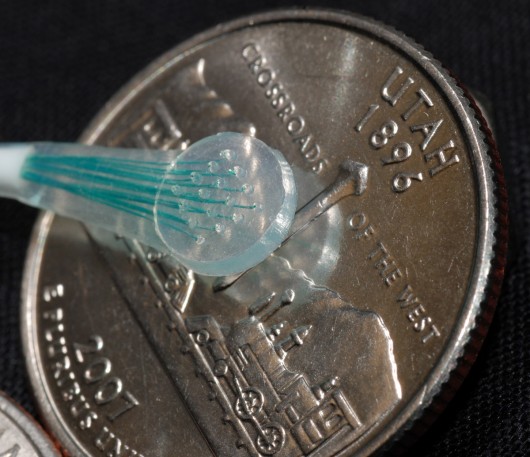
Using the same technology that allowed them to accurately detect the brain signals controlling arm movements that we looked at last year, researchers at the University of Utah have gone one step further, translating brain signals into words. While the previous breakthrough was an important step towards giving amputees or people with severe paralysis a high level of control over a prosthetic limb or computer interface, this new development marks an early step toward letting severely paralyzed people speak with their thoughts.
Nonpenetrating microECoGs
For their study the research team placed grids of tiny microelectrodes over speech centers of the brain of a volunteer with severe epileptic seizures. These nonpenetrating microelectrodes, called microEC0Gs, are implanted beneath the skull but sit on top of the brain without poking into it. The volunteer already had a craniotomy – temporary partial skull removal – so doctors could place larger, conventional electrodes to locate the source of his seizures and surgically stop them.
Because the microelectrodes do not penetrate brain matter, they are considered safe to place on speech areas of the brain – something that cannot be done with penetrating electrodes that have been used in experimental devices to help paralyzed people control a computer cursor or an artificial arm. Additionally, EEG electrodes used on the skull to record brain waves are too big and record too many brain signals to be used easily for decoding speech signals from paralyzed people.
Each of two grids with 16 microECoGs spaced 1 millimeter (about one-25th of an inch) apart, was placed over one of two speech areas of the brain: First, the facial motor cortex, which controls movements of the mouth, lips, tongue and face – basically the muscles involved in speaking. Second, Wernicke’s area, a little understood part of the human brain tied to language comprehension and understanding.
Translating nerve signals into words
Once in place the experimental microelectrodes were used to detect weak electrical signals from the brain generated by a few thousand neurons or nerve cells. During one-hour sessions conducted over four days the scientists recorded brain signals as the patient repeatedly read each of 10 words that might be useful to a paralyzed person: yes, no, hot, cold, hungry, thirsty, hello, goodbye, more and less. Each of the 10 words was repeated from 31 to 96 times, depending on how tired the patient was.
Later, they tried figuring out which brain signals represented each of the 10 words. When they compared any two brain signals – such as those generated when the man said the words “yes” and “no” – they were able to distinguish brain signals for each word 76 percent to 90 percent of the time.








